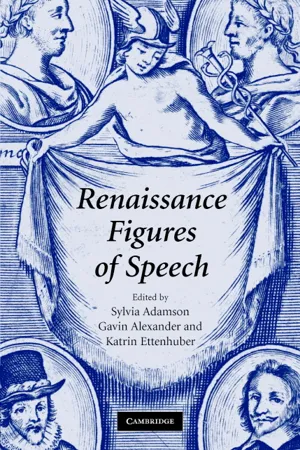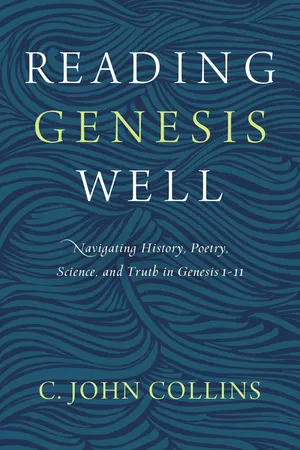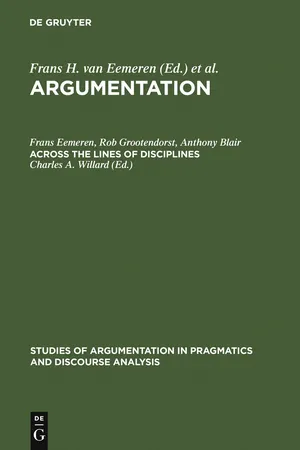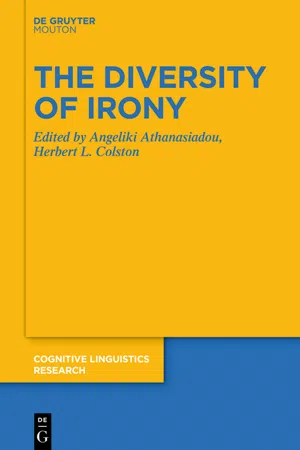Languages & Linguistics
Hyperbole
Hyperbole is a figure of speech that involves exaggeration for emphasis or effect. It is often used in literature, poetry, and everyday speech to create a dramatic or humorous effect. Hyperbole can be used to make a point, to evoke strong emotions, or to create a memorable image.
Written by Perlego with AI-assistance
Related key terms
1 of 5
5 Key excerpts on "Hyperbole"
- eBook - PDF
- Sylvia Adamson, Gavin Alexander, Katrin Ettenhuber(Authors)
- 2007(Publication Date)
- Cambridge University Press(Publisher)
Biron’s indictment of stylistic affectation crystallises around one specific figure: Hyperbole. 1 In the definition prefaced to this chapter, the sixteenth- century theorist Henry Peacham describes it as ‘a sentence or saying sur- mounting the truth’; 2 Richard Lanham, in his influential modern update of the rhetoric handbooks, refers to Hyperbole as ‘exaggerated or extrava- gant terms used for emphasis’. 3 The Greek term meant literally ‘a throwing beyond’. 4 Its Latin synonyms, superlatio (literally, ‘the raising to a higher degree’) and superiectio (‘the action of transcending a limit’), help to illus- trate Hyperbole’s trajectory: it covers a broad spectrum of exaggeration and intensification, from the mildly implausible to the downright impossible. 5 Readers of classical and early-modern rhetoric handbooks may have recognised in Biron’s speech a familiar note of distrust: throughout the his- tory of rhetoric, Hyperbole’s reputation has been unprepossessing to say the 197 198 katrin ettenhuber least. Most theoretical treatments of the figure are far from straightforward; Hyperbole’s usefulness is rarely taken for granted and, once established, almost invariably hedged about with elaborate instructions, caveats, and qualifications. Some writers even argue that Hyperbole can become a stylistic vice, and advise the orator to dispense with its services altogether. 6 This chapter will start by examining some of the most trenchant cri- tiques of Hyperbole, showing how the distrust of rhetorical exaggeration is implicated in larger aesthetic, philosophical and moral concerns. It will then map out two alternative narratives of hyperbolical language, which portray the device in a more positive light. The first of these re-evaluates the discourse of exaggeration by redefining the limits of decorum: as the range of appropriate rhetorical subjects is extended, theorists reconsider Hyperbole’s place in the world of figures. - eBook - ePub
Reading Genesis Well
Navigating History, Poetry, Science, and Truth in Genesis 1-11
- C. John Collins(Author)
- 2018(Publication Date)
- Zondervan Academic(Publisher)
14 Alan Millard, familiar with historiographical conventions from the ancient Near East, suggests that Hyperbole is well-attested, and there is no reason to resist finding it in the Bible:To speak of Solomon’s wealth as so great that silver had no value, “as common in Jerusalem as stones” (1 Kgs 10:27), is oriental Hyperbole of exactly the same sort as the assertions by indigent Mesopotamian kings who wrote to the Pharaoh, “Gold is like dust in your land, one simply scoops it up” (El Amarna Letters 16, 19, 20, 29). The writers were describing unusual riches in phrases that convey the thought clearly enough, without demanding a literal interpretation.15The Christian pastor John Stott (1921–2011) serves as an example of someone using good sense in the way he intuitively discerns some of the rhetorical tropes in the Bible. In his popular commentary on the Sermon on the Mount,16 he identified a paradox in the form of the Beatitudes: “Happy(blessed) are the unhappy” (on Matt 5:4). Its function is to draw attention to the way Jesus “contradicted all human judgments.”17 He also recognized, without using the terms, that the instruction “do not let your left hand know what your right hand is doing” (Matt 6:3) is either Hyperbole or adynaton: “Of course it is not possible to obey this command of Jesus in precise literalness.”18 - eBook - PDF
- Frans H. van Eemeren, Rob Grootendorst, J. Anthony Blair, Charles A. Willard, Frans H. van Eemeren, Rob Grootendorst, J. Anthony Blair, Charles A. Willard(Authors)
- 2011(Publication Date)
- De Gruyter Mouton(Publisher)
Hyperbole works the other way round. Here I say something stronger than what I have a right to say with the intention of having it corrected away from the extreme, but still to something strong hat preserves the same polarity. When someone claims to be famished, he is typically indicating that he is very hungry. Hyperbole is an exaggeration on the side of the truth. These contrasts are reflected in the following diagram: + UNDER-HVPEP.eOLE STATEMENT IRONV In passing, this diagram looks similar to one found in Nelson Goodman's The Language of Art. (See p. 268.) Goodman's leading idea is that the figures of speech that I have discussed, plus some others, are instances of metaphors·, indeed, he discusses them under the heading 'Modes of Metaphor'. For Goodman, and here he largely follows Max Black, a metaphor involves the transfer of a schema. At times this involves a movement from one realm to another disjoint from it (as in standard poetic conceits). At other times they are not disjoint, but, instead, 'one realm intersects or is an expansion or contraction of the other'. Applying this idea to figures of speech, he continues: In Hyperbole, for instance, an ordered schema is displaced downward. The large olive becomes supercolossal and the small one large. ... In litotes, or understatement, exactly the opposite occurs. A superb performance becomes pretty fair and a good one passable. 12 268 Robert J. Fogelin 'Large' — L-•S J · 'Small' a b c d e f a. Literal application c. Understatement e. Underemphasis b. - eBook - ePub
Writing on the Edge
Paul's Use of Hyperbole in Galatians
- Charles E. Cruise(Author)
- 2019(Publication Date)
- Pickwick Publications(Publisher)
Presumptive Meanings , 104 –8 ; Huang, Pragmatics , 49 –54 .274 . Claridge, Hyperbole in English , 102 –11 .275 . Norrick, “Hyperbole,” 201 .276 . Colston, Using Figurative Language , 196 .277 . Claridge, Hyperbole in English , 4 2 . Claridge adds that composite Hyperbole may also be metonymic in nature (43 ). See also Lausberg, Handbook of Literary Rhetoric , §579 , “The intended vertical shift can be expressed and made concrete by means of a horizontal (thus metaphorical) shift (‘hyperbolic metaphor’).”278 . From Pomerantz, “Extreme Case Formulations,” 219 .279 . Norrick, “Hyperbole,” 201 , “Overstatement occurs any time a speaker makes a claim higher (or lower) on some scale than warranted, while ECFs make claims involving the end points on such scales.”280 . Norrick, “Hyperbole, Extreme Case Formulation,” 1730 .281 . Norrick, “Hyperbole, Extreme Case Formulation,” 1733 .282 . Pomerantz, “Extreme Case Formulations,” 227 –28 . See Norrick, “Hyperbole, Extreme Case Formulation,” 1727 –39, on the differences between ECF and non-extreme Hyperbole.283 . Edwards, “Extreme Case Formulations,” 364 .284 . Spitzbardt, “Overstatement and Understatement,” 278 –80 , with one representative example included for each category.285 . Claridge, Hyperbole in English , 49 –70 .286 . McCarthy and Carter, “‘There’s Millions of Them,’” 179 –80 .287 . Jenni, “Sprachliche Übertreibungen,” 76 –83 .288 . Huang, Pragmatics , 119 .289 . Austin, How to Do Things with Words , 98 –99 , offers examples of illocutionary acts: “asking or answering a question, giving some information or an assurance or a warning, announcing a verdict or an intention, pronouncing sentence, making an appointment or an appeal or a criticism, making an identification or giving a description, and the numerous like.”290 . Austin, How to Do Things with Words - eBook - ePub
- Angeliki Athanasiadou, Herbert L. Colston, Angeliki Athanasiadou, Herbert L. Colston(Authors)
- 2020(Publication Date)
- De Gruyter Mouton(Publisher)
The cases of never and always showed that, in Hyperbole, there is not only just a shift and adjustment on the scale between what is said and what is meant. Attitude and exaggeration are part of the input in Hyperbole – an exaggeration of a state of affairs informs the input, specifically the choice for what is being contrasted against. In Hyperbole there is no distinct isomorphic pairing of linguistic forms to hyperbolic meanings. Hyperbolic meanings are dependent on a salient contrast (and where it lies) as well as the nature of that contrast relative to a speaker’s attitude and that speaker’s subjective evaluation. It is informative to look at borderline examples. When is tiny hyperbolic? It is hyperbolic the more its use moves away from objective to subjective assessment. It is hyperbolic when used to describe something that is smaller than expected or wanted (thereby creating a salient contrast). In general, the production of Hyperbole aims for the portrayal of some subjective attitude, while the comprehension of Hyperbole is to pick up on that attitude. References Brdar-Szabó, Rita & Mario Brdar. 2010. “Mummy, I love you like a thousand ladybirds:” Reflections on the emergence of hyperbolic effects and the truth of Hyperboles. In Armin Burkhardt & Brigitte Nerlich (eds.), Tropical truth(s): The epistemology of metaphor and other tropes, 383–427. Berlin & New York: De Gruyter. a, b, c, d, e Cappelen, Herman & Ernie Lepore. 2005. A defense of semantic minimalism and speech act pluralism. Malden: Blackwell. → Carston, Robyn & Cathering Wearing. 2015. Hyperbolic language and its relation to metaphor and irony. Journal of Pragmatics 79 (May). 79–92. http://doi.org/10.1016/j.pragma.2015.01.011 (accessed 6 May 2016). a, b Colston, Herbert L. 2015. Using figurative language. New York: Cambridge University Press. a, b, c Colston, Herbert L. & Shauna B. Keller. 1998
Index pages curate the most relevant extracts from our library of academic textbooks. They’ve been created using an in-house natural language model (NLM), each adding context and meaning to key research topics.




